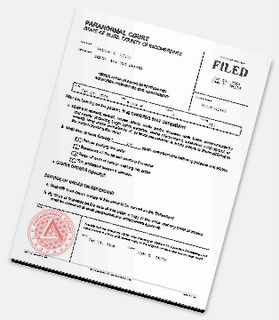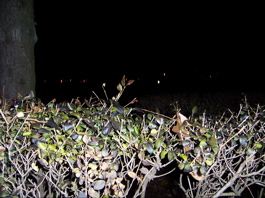A few nights ago, Pete and I watched
Christina Cooks on a PBS station, probably on
WLIW Create, and I was trying to explain to him why this cooking show perplexed me. I'm smart!
Tata: I don't...why's she...what did she just...what's in that pan?...that's the first time I've heard her say
vegetarian...Pete, did you see her toss pecans into that pecan bundt cake?
Pete: Nope, but I've seen guys direct traffic with less gestures.
Tata: I get emotional!
Pete did all his homework at the Culinary Institute, sometimes without a hangover. He has forgotten more than I will ever know about food. Yesterday, he called from his house.
Tata: What time will you be here?
Pete: In about 25 minutes. Why?
Tata: Dinner's almost ready.
Pete:
It is?The note of panic in his voice is barely concealed when I get up and walk toward the kitchen. "Where ya going?" he asks, as if he expects I spent forty years foraging in produce sections and Chinese buffets. I can't cook, right? That doesn't mean I
don't, which brings us to
this.Foodie restaurants love this ritzy Italian corn porridge they like to call "polenta."
What?
I can take you to places in San Francisco where a plate of simple polenta, beautifully presented for lunch and topped with a spoonful of marscapone cheese, will set you back $12, not counting the side salad and a glass of Napa gewurtz to wash it down with.
Of course, being half-hillbilly, I find this ridiculous. (Delicious, and I'll pay it, but ridiculous nonetheless.) Back in the day, in the two-room cabin I called home until I was 10, my mama made the exact same stuff, packed it with Velveeta, and called it cheese grits. Since we lived so far out that she only went into town shopping once a month, grits - served alongside some canned peas and a few pan-fried rainbow trout we caught in the creek - were standard empty-pantry fare in that last week before Mom went back into town.
This time of year, when it's cold and howling out, grits (polenta, if you insist) are a great winter comfort food.
I do insist.
Wikipedia:
Polenta is a dish made from boiled cornmeal. Although the word is borrowed into English from Italian, the dish (under various names) is popular in Italian, Savoyard, Swiss, Austrian, Croatian, Cuban, Hungarian, Slovenian, Serbian, Romanian, Bulgarian, Georgian, Corsican, Argentine, Uruguayan, Brazilian, Peruvian, Venezuelan, and Mexican cuisines, and it is a traditional staple food throughout much of northern Italy.
Maize or corn was a new world crop the Mesoamericans cultivated a long, long time before the Spanish arrived, so if the question is "Whose cuisine is more authentic, the guinea's or the hillbilly's?" we're not even in the correct ethnic ballpark. That said, poor people all over the planet have subsisted on cornmeal mushes in the last 500 years. So. I get emotional! The last little tiff I had with Dad before his diagnosis a year ago was about why he was writing recipes putting heavy cream and asiago into polenta when good cornmeal, stock and fragrant herbs were all a home chef and her waistline needed. I agree with Sara that the upscaling of polenta is stupid. It's a delight we can all afford and make for ourselves. On the other hand, Quaker makes Instant Grits, and if you need it right now, that crap's microwaveable.
When Daria, Todd and I were kids, Grandma and Grandpa LongItalianLastName only took out the stock pot on special occasions. The thing about peasant food nobody mentions is that it takes all damn day to make and a lot of freaking effort, so: in modern life, for a family of modest means, the old ways can represent a substantial investment in keeping them special and viscerally important to the next generation. This is the farthest thing from
ritzy. Grandma boiled salted water and added the yellow cornmeal. Grandpa, plainly in charge, wielded the polenta stick. Yes, we had a polenta stick, specifically for stirring polenta. It's in my kitchen right now. Making polenta from scratch for a big group is no exercise for the faint of heart or weak of bicep. After Grandpa died, Grandma switched to quicker cooking polenta, which involved less machismo but the same amount of wood because the exercise was still the same: someone held the pot and someone stirred until his or her arms fell off, the goo was poured out onto the polenta board - also in my kitchen - to cool a bit. Then we ate, because by this time, we were all muscle-bound and starving. Now, I make this at home all the time because, you know, I possess the freakish upper body strength.
The thing about polenta made this way was the development of fantastic yellow corn flavor, which is a different corn flavor from grits. The difference starts in how the cornmeal is processed at the mill and continues in the kitchen. I don't have a special palate or anything, but I've spent enough time in an Italian kitchen, in the South and in an Italian kitchen
in the South to be able to tell the difference. This is also why I love the Oaxaquenian tamales. Same stuff. Different. Ooh la la.
On Christina's
Cool Products page, I was surprised to find DiBruno Bros., my favorite cheesemonger in Philadelphia, and Frey Wines. Sometimes, I understand the principles of the recipe Christina's using, sometimes I don't. She doesn't seem to use dairy or alcohol at all, so maybe I don't understand what she's doing. Much. Often. I get emotional!
That happens a lot, actually.
Labels: compote something
 Daria's going to have some sort of seizure when she can't call me five times a day. Today, she called me at the library. Later, she called the family store.
Daria's going to have some sort of seizure when she can't call me five times a day. Today, she called me at the library. Later, she called the family store. 



























